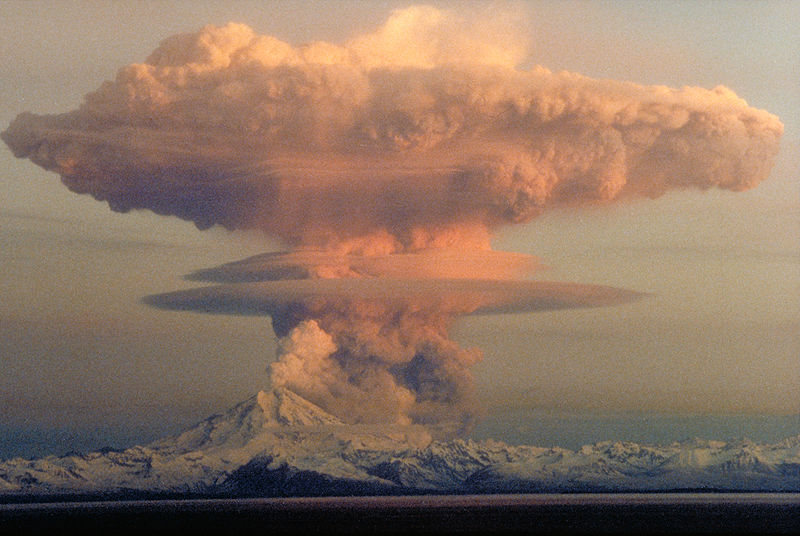To make a mushroom cloud
Not all mushroom clouds are nuclear, but that doesn’t mean any old boom will do
Jennifer Hackett • June 26, 2015

Don’t be alarmed: Alaska has not yet been nuked. Volcanoes are nature’s source of these distinctly shaped plumes. [Image credit: Wikimedia Commons]
I’m not certain Hollywood is aware of this, but to get a mushroom cloud you need a specific sort of boom. Your run-of-the-mill collection of fireworks won’t do it, and your played-for-laughs cooking fiascos on TV definitely won’t either. But don’t make the mistake of assuming that only one type of explosion gets to make mushrooms: Nuclear bombs aren’t the only pyrocumulus producers out there. It’s not as easy as the movies make it look, but with enough energy or heat, the sky’s the limit for what can cause the most distinctive sight a bomb can make.
Before we can figure out what can cause one, we need to know why mushroom clouds, more fancily referred to as pyrocumulus clouds, form in the first place. Imagine an air balloon’s ascent into the sky, fueled by hot air caught up in a brightly colored thin tarp. Now make the balloon’s launch incredibly violent — less of an ascent, and more of an explosion — and you’ve got yourself the recipe for a mushroom cloud. If an explosion causes the air around the balloon to get hot enough, buoyancy will kick in, making the hot air rise up like a cork placed in the bottom of a water-filled bathtub. This is because the hotter air has a lower density — it’s moving more rapidly while also taking up more space than its chillier, lethargic surrounding air.
As the hot air rises, it heats the air it passes through while shoving the cooler air out of its way. This warmed-up column of air trails behind the accelerating mass of hot air like a kite’s string, pulling dust and debris up along with it. This debris is vital: It’s the part of the cloud we can actually see, illustrating the violent interplay of hot and cold gases that takes place when a mushroom cloud is triggered by an explosion superheating the air around it.
Where the suddenly low-density hot air and cooler air meet, something called a Rayleigh-Taylor instability is formed. A Rayleigh-Taylor instability happens whenever you have a higher density fluid (a liquid or a gas) resting atop a lower density one. The column created by the explosion has just this odd structure. The lighter (hotter) air pushes against the heavier (colder) air, shoving the heavier air aside and causing more energy to be released. The rising hot air slightly heats the normal air it passes directly, which causes it to rise as well.
The original hotter air gets pushed even higher as a result, as though our theoretical balloon were dropping ballast bags. The gases in the air swirl together, curling downward as the colder air tries to sink despite the hotter, buoyant air dragging it upward. Meanwhile the core of hot air is still rising, with the cooler air is trailing off around its circumference in curling tendrils.
All this action sets the stage for the mushroom to emerge as soon as it reaches its equilibrium point. Once the rising mass of hot air becomes the same temperature as its surroundings, it stops rising and gravity says it must start falling. The chaotic swirls of different-density gases puff out as they fall, carrying the dust from below with them. And finally, the mushroom emerges.
Any explosion energetic enough can create a ‘shroom-shaped cloud — but don’t take that to mean it’s easy. Nuclear bombs are the most notable, but extremely powerful conventional weapons (we’re talking thousands of pounds of explosive power, starting at 15,000 tons of TNT) can put on a mushroom show as well. And don’t think nature hasn’t gotten in on the mushroom cloud action: Volcanoes were the original mushroom cloud maker, although in this age, eruptions like Mt. Redoubt’s look eerily like we dropped a nuke on Alaska.
2 Comments
Where did you get the “15,000 tons of TNT” figure for a non-nuclear explosion creating a mushroom cloud? Am I understanding you correctly when I say that this means if an explosion has an explosive yield less than 15,000 tons of TNT, it cannot form a tall, column-shaped cloud with vortex rings?
You can form a mushroom cloud in a lab under the correct conditions, but traditionally using explosives, it seems to take about 100 tons of TNT to do it. Or something of equal power.